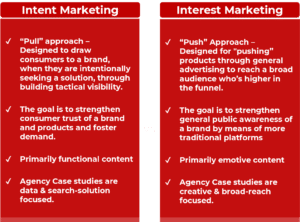Do you have a great product but not enough sales? You’re not alone. Many businesses find themselves in the same boat. And usually, this is because people simply don’t know about what you have to offer and how it could benefit them.
This is what marketing is all about – getting your offering in front of the right people, at the right time, and creating awareness and interest in your product or service so that people will buy it. Without a good marketing strategy, your business will struggle to make any sales at all.

But marketing is a broad and complex topic, with a myriad of different strategies and channels to choose from. So, how do you know which marketing strategy is right for your business?
In this post, we’ll be looking at two of the most popular types: interest-based targeting and intent-based marketing. We’ll explain what the difference is, what kinds of organisations they work best for, and look at some of the pros and cons of Interest vs Intent marketing strategies.
Of course, there’s no law that says you can’t do both! The best marketing strategy for your business might well be a combination of both intent and interest techniques. Read on to find out more.
Overview of Intent vs Interest Marketing Strategies
Rather than how you market to your audience, intent and interest marketing strategies are all about what you say to your target market.
Interest marketing definition
Interest-based marketing (also called buyer focused marketing) is a type of advertising that specifically targets users based on their interests. This is normally done through cookies, which track user behaviour online. By collecting this data, companies are able to deliver more relevant ads to users, which can lead to increased sales and brand loyalty.
Additionally, interest-based marketing can help to reduce the number of unwanted or irrelevant ads that users are exposed to. When done correctly, interest-based marketing can be an effective way to reach target audiences with customized messages.
While traditional marketing attempts to reach as many people as possible, interest-based marketing takes a more targeted approach. The goal is not simply to attract attention, but to create a connection with the audience that leads to conversions.
Anyone who spends time online has probably noticed that the kinds of ads you see seem to be tailored (sometimes a little eerily so) to your interests – or at least related to content and topics that you’ve researched before. This is interest-based marketing in action.
Interest marketing example
If you sell products or services related to gardening, you could create content about garden design tips, plant care, or new gardening products. Alternatively, you could develop targeted campaigns around spring planting or summer gardening.
Intent marketing definition
Intent-based marketing is a data-driven approach to marketing that focuses on understanding and responding to customer needs and goals. The goal of intent-based marketing is to create a seamless and personalized customer experience that meets the customer’s needs at every stage of their journey.
To do this, marketers need to have a deep understanding of the customer’s intent – what they need or want to achieve. By using data to understand the customer’s intent, marketers can provide them with the information and resources they need, when they need it, in order to help them achieve their goals.
The aim of intent-based marketing is to convert potential customers into actual customers by providing them with the information they need at the right time. This type of marketing can be highly effective because it allows businesses to focus their efforts on those consumers who are most likely to be interested in what they have to offer.
Intent marketing example
One common example of intent marketing is retargeting ads. These are the ads that follow you around the internet after you’ve visited a certain website or looked at a particular product. For instance, say you’re shopping for a new pair of shoes. You visit several different websites, looking at different styles and brands. Once you leave the shoe shopping sites, you may start to see ads for shoes on other websites you visit. That’s because cookies have been placed on your computer that allow them to track your web activity and serve you relevant ads based on intent targeting keywords.
What is the difference between intent and interest?
Intent strategies focus on selling a specific product or service to customers who are already interested in what you have to offer. Interest strategies, on the other hand, focus on generating interest in your brand among potential customers who may not yet be familiar with your product or service.
What is interest-based targeting / marketing?
With this method, you focus on creating content that appeals to the general interests of your target market. For example, if you sell outdoor gear, you might create blog posts about hiking trails in your area or tips for camping in the wilderness. You can then promote this content across various channels, such as social media, email marketing, and paid ads.
What is intent digital marketing?
This type of marketing focuses on reaching customers who are actively searching for products or services like yours. For example, if someone searches for “hiking gear shop near me,” they have expressed an intention to buy hiking gear from a store in their vicinity. You can capture these leads by optimizing your website for SEO and running targeted ads.

Pros and cons of interest-based vs intent-based marketing
Pros of interest-based marketing
On the plus side, interest-based marketing allows you to laser-focus your messages, ensuring that they are relevant to your target audience. This can result in higher conversion rates and more engaged customers. Additionally, customers who feel like they are being spoken to directly may be more likely to have a positive impression of your brand.
Cons of interest-based marketing
On the downside, interest-based marketing can be perceived as intrusive or even creepy if not done well. There is also the risk of alienating potential customers who do not fit into your target demographic. Finally, it is important to remember that interests can change over time, so you will need to regularly update your targeting criteria to stay ahead of the curve.
Pros of intent-based marketing
- Allows businesses to be more efficient with their marketing budgets by only targeting consumers who have expressed an interest in their products or services.
- Can lead to higher conversion rates because the ads and content are relevant to the consumer’s needs.
- Gives businesses the opportunity to build relationships with potential customers by providing them with helpful information during their buyer’s journey.
Cons of intent-based marketing
However, there are also some challenges associated with intent-based marketing. One is that it requires access to high-quality data, which can be expensive. Additionally, intent-based marketing can be difficult to scale if a business is targeting a large number of consumers with different needs.
What is the most effective business marketing strategy?
The bottom line is that there is no one-size-fits-all answer to the question of what the best marketing strategy for your business is. The best marketing strategy for a small business with a limited budget and small target audience will be quite different from that of an established international brand.
In addition, you should think about whether a push or pull marketing strategy will better resonate with your target audience. You can learn more about these in our blog: Push vs Pull Marketing Strategies.
To determine which strategy is right for you, assess your goals and objectives and then choose a strategy that aligns with those. And remember that all of these strategies can (and optimally should) work in tandem to reach prospects in different phases of the decision-making process.
From our experience, intent-based marketing can be more effective than interest-based marketing in terms of conversion rates and ROI. In addition, intent-based marketing is less likely to result in wasted impressions, as businesses only pay for ads that are served to people who have expressed an interest in their product or service.
If you’re not sure where to start, our team of experts can help you develop a custom intent-focused marketing plan that will help you achieve your desired results. Contact us today to learn more!



